Content for TS 24.501 Word version: 18.7.0
1…
3…
4…
4.4…
4.4.3…
4.5…
4.5.3…
4.6…
4.7…
4.9…
4.15…
5…
5.2…
5.3…
5.3.2…
5.3.7…
5.3.19…
5.4…
5.4.1.3…
5.4.2…
5.4.4…
5.4.5…
5.4.6…
5.5…
5.5.1.2.4
5.5.1.2.5…
5.5.1.3…
5.5.1.3.4
5.5.1.3.5…
5.5.2…
5.6…
5.6.2…
6…
6.1.4…
6.2…
6.3…
6.3.2…
6.3.3…
6.4…
6.4.1.4…
6.4.2…
6.5…
7…
8…
8.2.9…
8.3…
9…
9.11.2…
9.11.2.10…
9.11.3…
9.11.3.4…
9.11.3.8…
9.11.3.14…
9.11.3.18C…
9.11.3.29…
9.11.3.33…
9.11.3.39…
9.11.3.45…
9.11.3.50…
9.11.3.53A…
9.11.3.68…
9.11.3.75…
9.11.4…
9.11.4.10…
9.11.4.13…
9.11.4.16…
9.11.4.30…
9.12
10…
A…
B…
C…
D…
D.6…
D.6.3…
D.6.8
D.7…
9.11.3.50 Service type
9.11.3.50A SMS indication
9.11.3.51 SOR transparent container
9.11.3.51A Supported codec list
9.11.3.52 Time zone
9.11.3.53 Time zone and time
...
...
9.11.3.50 Service type p. 936
The purpose of the service type information element is to specify the purpose of the service request procedure.
The service type is a type 1 information element.
The service type information element is coded as shown in Figure 9.11.3.50.1 and Table 9.11.3.50.1.

| Service type value (octet 1) | |
| Bits
4 3 2 1 | |
| 0 0 0 0 | signalling |
| 0 0 0 1 | data |
| 0 0 1 0 | mobile terminated services |
| 0 0 1 1 | emergency services |
| 0 1 0 0 | emergency services fallback |
| 0 1 0 1 | high priority access |
| 0 1 1 0 | elevated signalling |
| 0 1 1 1 | unused; shall be interpreted as "signalling", if received by the network |
| 1 0 0 0 | unused; shall be interpreted as "signalling", if received by the network |
| 1 0 0 1 | unused; shall be interpreted as "data", if received by the network |
| 1 0 1 0 | unused; shall be interpreted as "data", if received by the network |
| 1 0 1 1 | unused; shall be interpreted as "data", if received by the network |
| All other values are reserved. | |
9.11.3.50A SMS indication p. 936
The purpose of the SMS indication information element is to indicate that the ability for the UE to use SMS over NAS has changed.
The SMS indication information element is coded as shown in Figure 9.11.3.50A.1 and Table 9.11.3.50A.1.
The SMS indication is a type 1 information element.

| SMS availability indication (SAI) (octet 1) | |
| Bit
1 | |
| 0 | SMS over NAS not available |
| 1 | SMS over NAS available |
| Bits 2, 3 and 4 are spare and shall be coded as zero. | |
9.11.3.51 SOR transparent container p. 937
The purpose of the SOR transparent container information element in the REGISTRATION ACCEPT message is to provide the list of preferred PLMN/access technology combinations (or HPLMN indication that 'no change of the "Operator Controlled PLMN Selector with Access Technology" list stored in the UE is needed and thus no list of preferred PLMN/access technology combinations is provided'), or a secured packet (see TS 23.122 Annex C) and optional indication of an acknowledgement request, SOR-CMCI, request the storage of the received SOR-CMCI in the ME, SOR-SNPN-SI (or subscribed SNPN or HPLMN indication that 'no change of the SOR-SNPN-SI stored in the UE is needed and thus no SOR-SNPN-SI is provided'), and SOR-SNPN-SI-LS. The purpose of the SOR transparent container information element in the REGISTRATION COMPLETE message is to indicate the UE acknowledgement of successful reception of the SOR transparent container IE in the REGISTRATION ACCEPT message as well as to indicate the ME support of SOR-CMCI, the ME support of SOR-SNPN-SI and the ME support of SOR-SNPN-SI-LS.
The SOR transparent container information element is coded as shown in Figure 9.11.3.51.1, Figure 9.11.3.51.2, Figure 9.11.3.51.3, Figure 9.11.3.51.4, Figure 9.11.3.51.5, Figure 9.11.3.51.6, Figure 9.11.3.51.7, Figure 9.11.3.51.8, Figure 9.11.3.51.9, Figure 9.11.3.51.9A, Figure 9.11.3.51.10, Figure 9.11.3.51.11, Figure 9.11.3.51.11A, Figure 9.11.3.51.11B, Figure 9.11.3.51.11C, Figure 9.11.3.51.11D, Figure 9.11.3.51.11E, Figure 9.11.3.51.11F, Figure 9.11.3.51.11G, Figure 9.11.3.51.11H, Figure 9.11.3.51.11I, Figure 9.11.3.51.12, Figure 9.11.3.51.13, Table 9.11.3.51.1, Table 9.11.3.51.2, Table 9.11.3.51.3, Table 9.11.3.51.4, Table 9.11.3.51.4A, Table 9.11.3.51.5 and Table 9.11.3.51.6.
The SOR transparent container is a type 6 information element with a minimum length of 20 octets.
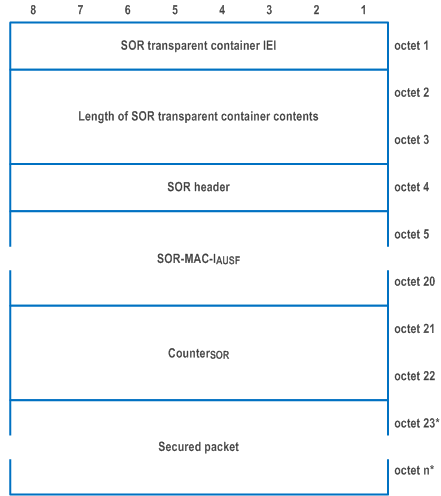
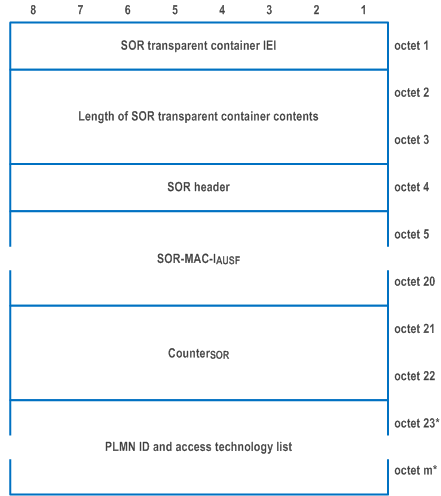
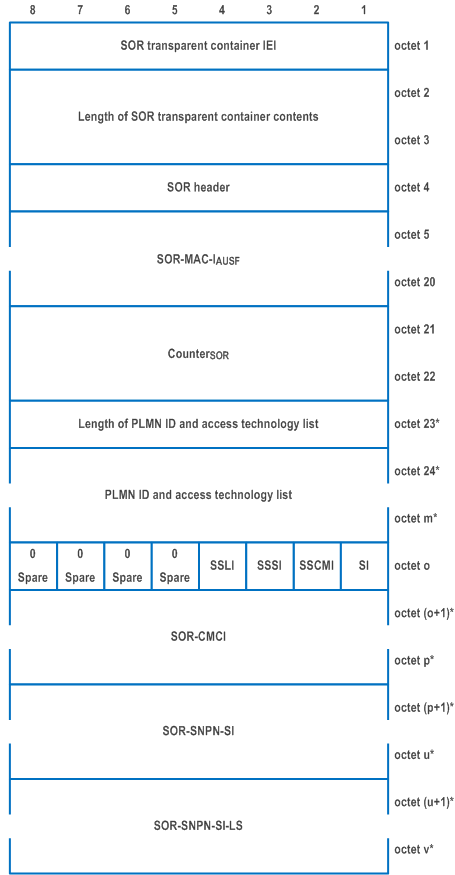
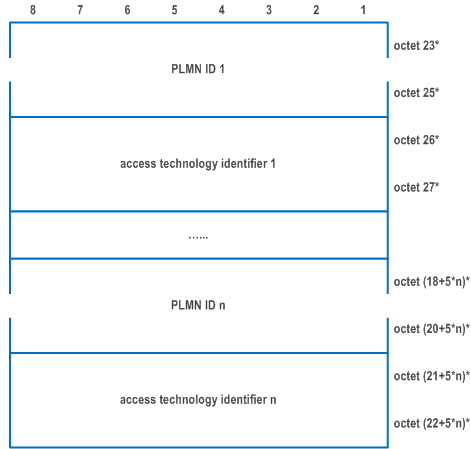
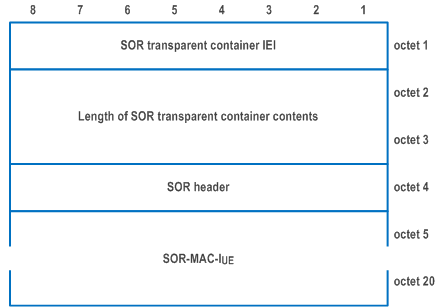


| SOR-MAC-IAUSF (see NOTE 1), SOR-MAC-IUE (see NOTE 2) and CounterSOR (see NOTE 1) are coded as specified in TS 33.501. | |
| SOR data type (octet 4, bit 1) | |
| 0 | The SOR transparent container carries steering of roaming information. |
| 1 | The SOR transparent container carries acknowledgement of successful reception of the steering of roaming information. |
| List indication (octet 4, bit 2) (see NOTE 1 and NOTE 5) | |
| 0 | HPLMN indication that 'no change of the "Operator Controlled PLMN Selector with Access Technology" list stored in the UE is needed and thus no list of preferred PLMN/access technology combinations is provided' |
| 1 | list of preferred PLMN/access technology combinations is provided |
| List type (octet 4, bit 3) (see NOTE 1) | |
| 0 | The list type is a secured packet. |
| 1 | The list type is a "PLMN ID and access technology list". |
| Acknowledgement (ACK) value (octet 4, bit 4) (see NOTE 1) | |
| 0 | acknowledgement not requested |
| 1 | acknowledgement requested |
| Additional parameters (AP) value (octet 4, bit 5) | |
| 0 | Additional parameters not included |
| 1 | Additional parameters included (see NOTE 3) |
If the SOR data type is set to value "0", the list type bit is set to value "1", and the additional parameters bit is set to value "1" then:
| |
| ME support of SOR-CMCI indicator (MSSI) value (octet 4, bit 2) (see NOTE 2, NOTE 4) | |
| 0 | SOR-CMCI not supported by the ME |
| 1 | SOR-CMCI supported by the ME |
| ME support of SOR-SNPN-SI indicator (MSSNPNSI) value (octet 4, bit 3) (see NOTE 2, NOTE 6) | |
| 0 | SOR-SNPN-SI not supported by the ME |
| 1 | SOR-SNPN-SI supported by the ME |
| MS support of SOR-SNPN-SI-LS indicator (MSSNPNSILS) value (octet 4, bit 4) (see NOTE 2) | |
| 0 | SOR-SNPN-SI-LS not supported by the ME |
| 1 | SOR-SNPN-SI-LS supported by the ME |
| SOR-CMCI indicator (SI) value (octet o, bit 1) | |
| 0 | SOR-CMCI absent |
| 1 | SOR-CMCI present |
| If the SOR-CMCI indicator bit is set to "SOR-CMCI present", the SOR-CMCI field is present. If the SI bit is set to "SOR-CMCI absent", the SOR-CMCI field is absent. | |
| Store SOR-CMCI in ME indicator (SSCMI) value (octet o, bit 2) | |
| 0 | Do not store SOR-CMCI in ME |
| 1 | Store SOR-CMCI in ME |
| SOR-CMCI (octet o+1 to octet p) | |
| The SOR-CMCI field is coded according to Figure 9.11.3.51.7 and Table 9.11.3.51.2. | |
| SOR-SNPN-SI indicator (SSSI) value (octet o, bit 3) | |
| 0 | subscribed SNPN or HPLMN indication that 'no change of the SOR-SNPN-SI stored in the UE is needed and thus no SOR-SNPN-SI is provided' |
| 1 | SOR-SNPN-SI present |
| If the SSSI bit is set to "SOR-SNPN-SI present", the SOR-SNPN-SI field is present. If the SSSI bit is set to "subscribed SNPN or HPLMN indication that 'no change of the SOR-SNPN-SI stored in the UE is needed and thus no SOR-SNPN-SI is provided'", the SOR-SNPN-SI is absent. | |
| SOR-SNPN-SI-LS indicator (SSSLI) value (octet o, bit 4) | |
| 0 | SOR-SNPN-SI-LS absent |
| 1 | SOR-SNPN-SI-LS present |
| If the SSSLI bit is set to "SOR-SNPN-SI-LS present", the SOR-SNPN-SI-LS field is present. If the SSSLI bit is set to "SOR-SNPN-SI-LS absent", the SOR-SNPN-SI-LS is absent. | |
|
NOTE 1:
This bit or field applies for SOR header with SOR data type with value "0".
NOTE 2:
This bit or field applies for SOR header with SOR data type with value "1".
NOTE 3:
Additional parameters can be set to value "1" only when the ME supports SOR-CMCI, SOR-SNPN-SI or SOR-SNPN-SI-LS, and the list type bit is set to value "1". The ME supporting SOR-SNPN-SI-LS supports SOR-SNPN-SI as specified in TS 23.122.
NOTE 4:
The "SOR-CMCI supported by the ME" is not set by a UE compliant to an earlier release of the specification.
NOTE 5:
This bit or field applies for SOR header with list type with value "1".
NOTE 5:
The "SOR-SNPN-SI supported by the ME" may only be set by a UE which supports access to an SNPN using credentials from a credentials holder and which is not operating in SNPN access operation mode.
|
|
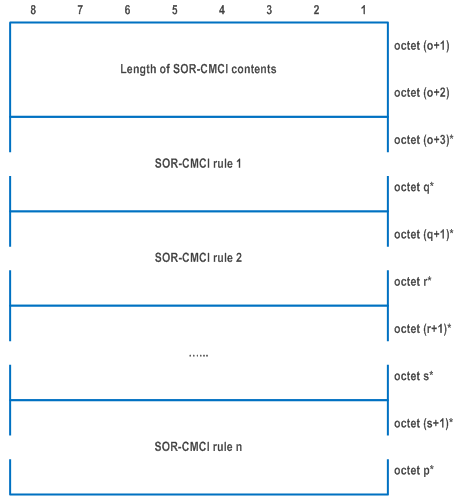
| SOR-CMCI rule: | |
| The SOR-CMCI rule is coded according to Figure 9.11.3.51.8 and Table 9.11.3.51.3. If the length of SOR-CMCI contents field indicates a length bigger than indicated in Figure 9.11.3.51.7, receiving entity shall ignore any superfluous octets located at the end of the SOR-CMCI. | |
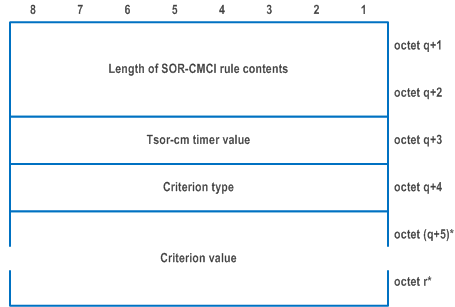
| Tsor-cm timer value | |
| The Tsor-cm timer value field is coded according to octet 2 of the GPRS timer information element as specified in subclause 10.5.7.3 of TS 24.008 and indicates the Tsor-cm timer value. When the unit field of the Tsor-cm timer value field indicates that the timer is deactivated, the receiving entity shall consider that Tsor-cm timer value is set to the infinity value. | |
| Criterion type | |
| Bits
8 7 6 5 4 3 2 1 | |
| 0 0 0 0 0 0 0 1 | DNN |
| 0 0 0 0 0 0 1 0 | S-NSSAI SST |
| 0 0 0 0 0 0 1 1 | S-NSSAI SST and SD |
| 0 0 0 0 0 1 0 0 | IMS registration related signalling |
| 0 0 0 0 0 1 0 1 | MMTEL voice call |
| 0 0 0 0 0 1 1 0 | MMTEL video call |
| 0 0 0 0 0 1 1 1 | SMS over NAS or SMSoIP |
| 0 0 0 0 1 0 0 0 | SOR security check not successful |
| 1 1 1 1 1 1 1 1 | match all |
| All other values are spare. The receiving entity shall ignore SOR-CMCI rule with criterion of criterion type set to a spare value. For "DNN", the criterion value field shall be encoded as a DNN length-value pair field. For "S-NSSAI SST", the criterion value field shall be encoded as one octet SST field. For "S-NSSAI SST and SD", the criterion value field shall be encoded as a sequence of one octet SST field and three octets SD field. The SST field shall be transmitted first. The DNN length-value pair field shall be encoded as a sequence of one octet DNN value length field and a DNN value field. The DNN value length field shall be transmitted first. The DNN value length field indicates the length in octets of the DNN value field. The DNN value field contains an APN as specified in TS 23.003. The SST field contains SST of HPLMN's S-NSSAI. The SD field contains SD of HPLMN's S-NSSAI. For "match all", "SOR security check not successful", "IMS registration related signalling", "MMTEL voice call", "MMTEL video call", and "SMS over NAS or SMSoIP", the criterion value field is zero octets long. If the length of SOR-CMCI rule contents field indicates a length bigger than indicated in Figure 9.11.3.51.8, receiving entity shall ignore any superfluous octets located at the end of the SOR-CMCI rule. The UE applies SOR-CMCI rules as described in TS 23.122 Annex C. | |
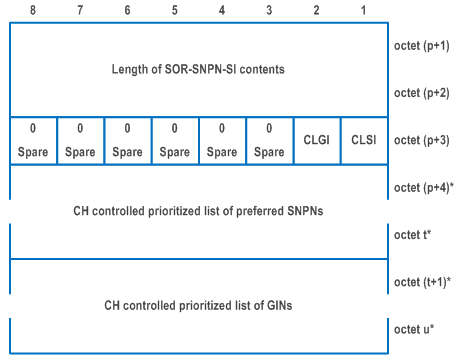
| CH controlled prioritized list of preferred SNPNs indicator (CLSI) value (octet p+3, bit 1) | |
| 0 | CH controlled prioritized list of preferred SNPNs absent |
| 1 | CH controlled prioritized list of preferred SNPNs present |
| If the CLSI bit is set to "CH controlled prioritized list of preferred SNPNs present", the CH controlled prioritized list of preferred SNPNs field is present. If the CLSI bit is set to "CH controlled prioritized list of preferred SNPNs absent", the CH controlled prioritized list of preferred SNPNs field is absent. | |
| CH controlled prioritized list of GINs indicator (CLGI) value (octet p+3, bit 2) | |
| 0 | CH controlled prioritized list of GINs absent |
| 1 | CH controlled prioritized list of GINs present |
| If the CLGI bit is set to "CH controlled prioritized list of GINs present", the CH controlled prioritized list of GINs field is present. If the CLGI bit is set to "CH controlled prioritized list of GINs absent", the CH controlled prioritized list of GINs field is absent. | |
| If the length of SOR-SNPN-SI contents field indicates a length bigger than indicated in Figure 9.11.3.51.9, receiving entity shall ignore any superfluous octets located at the end of the SOR-SNPN-SI. | |
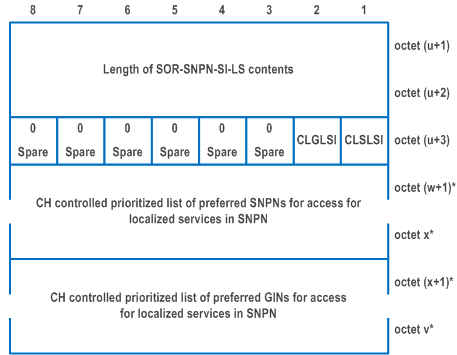
| CH controlled prioritized list of preferred SNPNs for access for localized services in SNPN indicator (CLSLSI) value (octet u+3, bit 1) | |
| 0 | CH controlled prioritized list of preferred SNPNs for access for localized services in SNPN absent |
| 1 | CH controlled prioritized list of preferred SNPNs for access for localized services in SNPN present |
| If the CLSLSI bit is set to "CH controlled prioritized list of preferred SNPNs for access for localized services in SNPN present", the CH controlled prioritized list of preferred SNPNs for access for localized services in SNPN field is present. If the CLSLSI bit is set to "CH controlled prioritized list of preferred SNPNs for access for localized services in SNPN absent", the CH controlled prioritized list of preferred SNPNs for access for localized services in SNPN field is absent. | |
| CH controlled prioritized list of preferred GINs for access for localized services in SNPN indicator (CLGLSI) value (octet u+3, bit 2) | |
| 0 | CH controlled prioritized list of preferred GINs for access for localized services in SNPN absent |
| 1 | CH controlled prioritized list of preferred GINs for access for localized services in SNPN present |
| If the CLGLSI bit is set to "CH controlled prioritized list of preferred GINs for access for localized services in SNPN present", the CH controlled prioritized list of preferred GINs for access for localized services in SNPN field is present. If the CLGLSI bit is set to "CH controlled prioritized list of preferred GINs for access for localized services in SNPN absent", the CH controlled prioritized list of preferred GINs for access for localized services in SNPN field is absent. | |
| If the length of SOR-SNPN-SI-LS contents field indicates a length bigger than indicated in Figure 9.11.3.51.9A, receiving entity shall ignore any superfluous octets located at the end of the SOR-SNPN-SI. | |
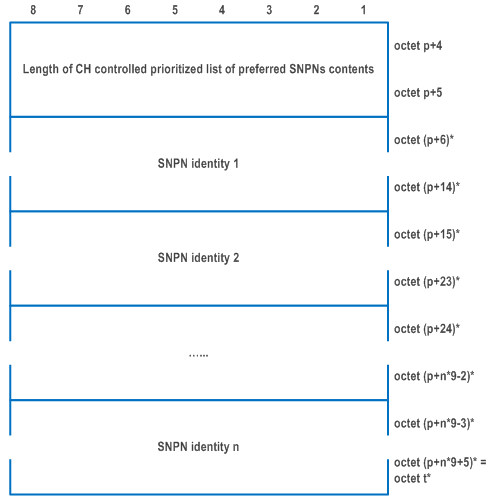
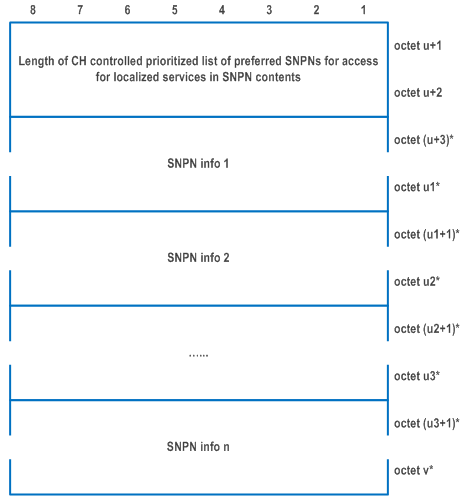
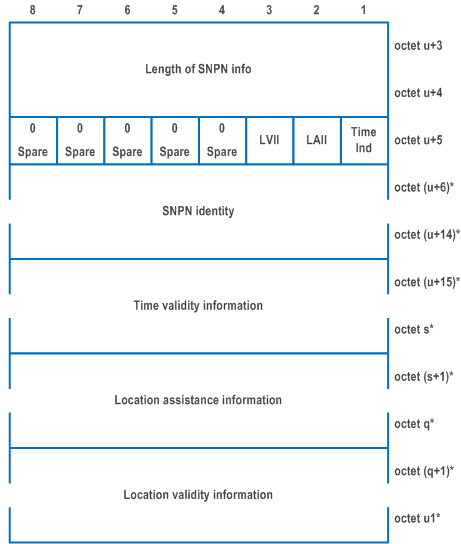
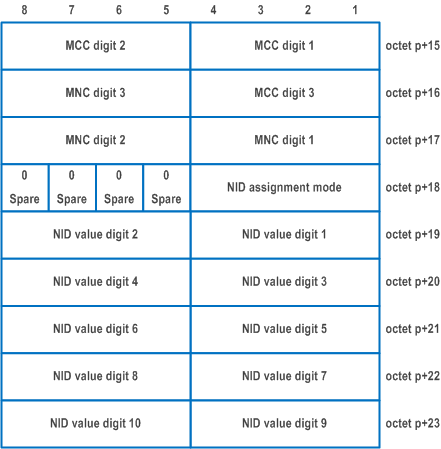
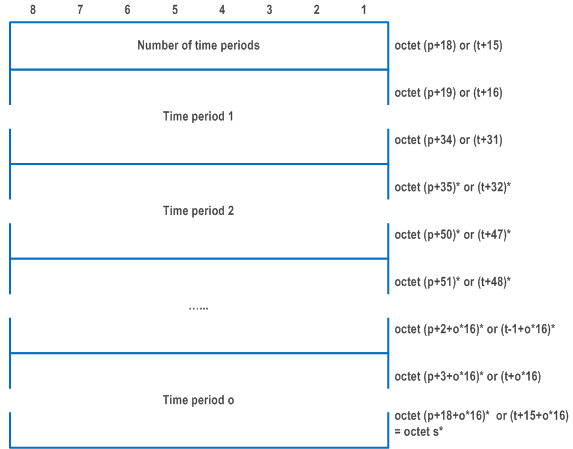
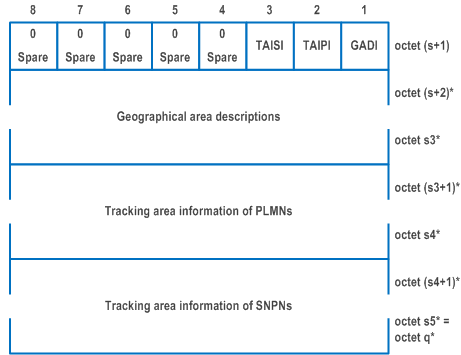
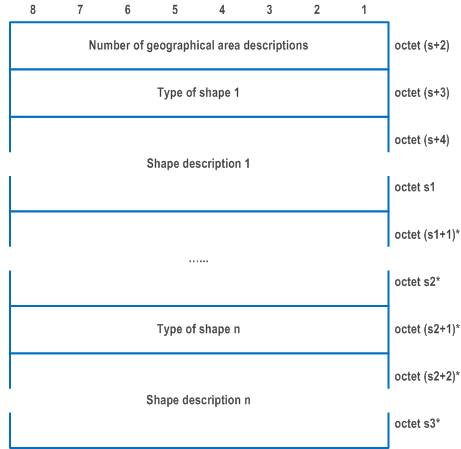
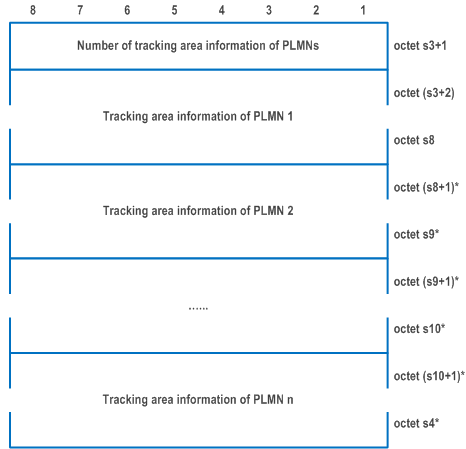
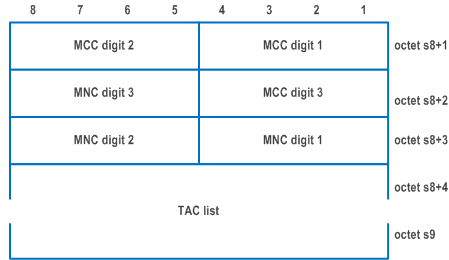
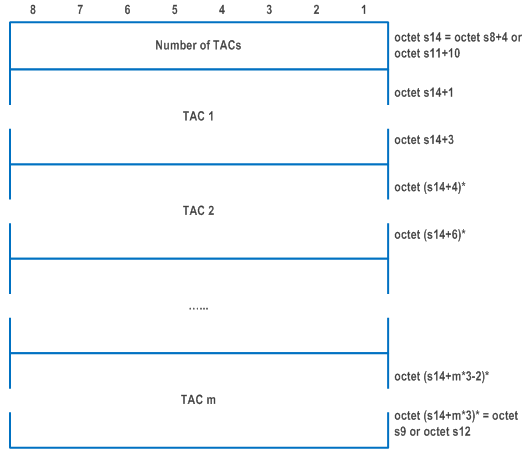
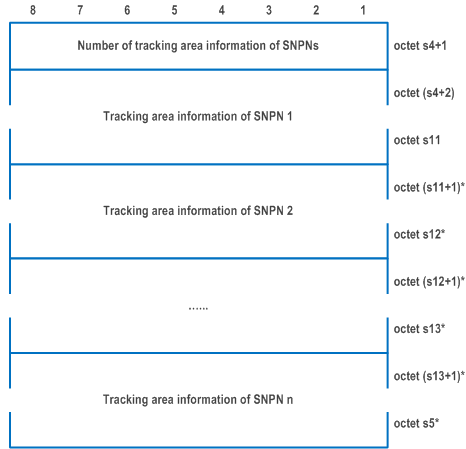
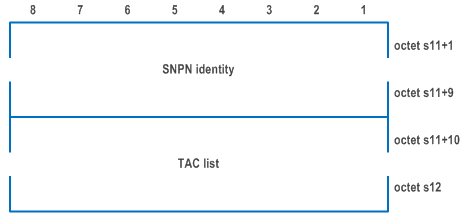
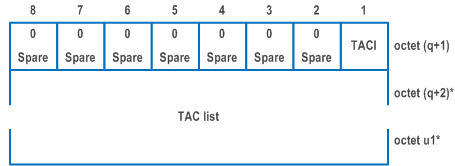
| Mobile country code (MCC): | |
| The MCC field is coded as in ITU-T Recommendation E.212 [42], Annex A. | |
| Mobile network code (MNC): | |
| The coding of MNC field is the responsibility of each administration but BCD coding shall be used. The MNC shall consist of 2 or 3 digits. If a network operator decides to use only two digits in the MNC, MNC digit 3 shall be coded as "1111". | |
| NID assignment mode (see NOTE 1) | |
| NID assignment mode is coded as specified in TS 23.003. | |
| NID value (see NOTE 1) | |
| NID value is coded as specified in TS 23.003. | |
| Time indication (bit1 of octet u+5) | |
| 0 | Time validity information is not included |
| 1 | Time validity information is included |
| Location assistance information indicator (LAII) (bit 2 of octet u+5) | |
| 0 | Location assistance information not included |
| 1 | Location assistance information included |
| Location validity information indicator (LVII) (bit 3 of octet u+5) | |
| 0 | Location validity information not included |
| 1 | Location validity information included |
| Tracking area code list indicator (TACI) (bit 1 of octet q+1) (see NOTE 2) | |
| 0 | TAC list not included |
| 1 | TAC list included |
| Geographical area descriptions indicator (GADI) (bit 1 of octet s+1) | |
| 0 | Geographical area descriptions not included |
| 1 | Geographical area descriptions included |
| Tracking area information of PLMNs (TAIPI) (bit 2 of octet s+1) | |
| 0 | Tracking area information of PLMNs not included |
| 1 | Tracking area information of PLMNs included |
| Tracking area information of SNPNs (TAISI) (bit 3 of octet s+1) | |
| 0 | Tracking area information of SNPNs not included |
| 1 | Tracking area information of SNPNs included |
| Location assistance information | |
| Location assistance information field contains the geographical area descriptions field, the tracking area information of PLMNs field, the tracking area information of SNPNs field. or any combination of them. | |
| Time period | |
| The time period field is coded as the route selection descriptor component value field for "time window type" specified in TS 24.526 Table 5.2.1. | |
| Type of shape | |
| Type of shape is coded as specified in Table 2a in TS 23.032. | |
| Shape description | |
| Shape description is coded as specified in subclause 7.3 in TS 23.032. | |
| Tracking area information of PLMNs | |
| Tracking area information of PLMNs field contains one or more tracking area information of PLMN fields. | |
| Tracking area information of PLMN | |
| Tracking area information of PLMN field contains an MCC and MNC of a PLMN identity and a TAC list field containing one or more tracking area code fields, each indicating a TAC of a PLMN identified by the PLMN identity. | |
| Tracking area information of SNPNs | |
| Tracking area information of SNPNs field contains one or more tracking area information of SNPN fields. If the tracking area information of SNPNs field is included in a location assistance information field of an SNPN info field, the SNPN identity field in each tracking area information of SNPN field of the tracking area information of SNPNs field is different from the SNPN identity field in the SNPN info field. | |
| Tracking area information of SNPN | |
| Tracking area information of SNPN field contains SNPN identity and a TAC list containing one or more tracking area code fields, each indicating a TAC of an SNPN identified by the SNPN identity. | |
| Tracking area code (TAC) | |
| In the TAC field bit 8 of the first octet is the most significant bit and bit 1 of third octet the least significant bit. The coding of the tracking area code is the responsibility of each administration. Coding using full hexadecimal representation may be used. The tracking area code consists of 3 octets. | |
|
NOTE 1:
NID coding deviates from coding of value part of NID IE as specified in subclause 9.2.7 of TS 24.502, coding of the NID field of the SNPN list IE as specified in subclause 9.11.3.92, and coding of the NID field of the SNPN list with trusted 5G connectivity IE as specified in subclause H.2.4.7 of TS 24.302.
NOTE 2:
If the location validity information indicator is set to 'Location validity information included' but TAC list indicator is set to 'TAC list not included', the UE shall ignore the location validity information.
|
|
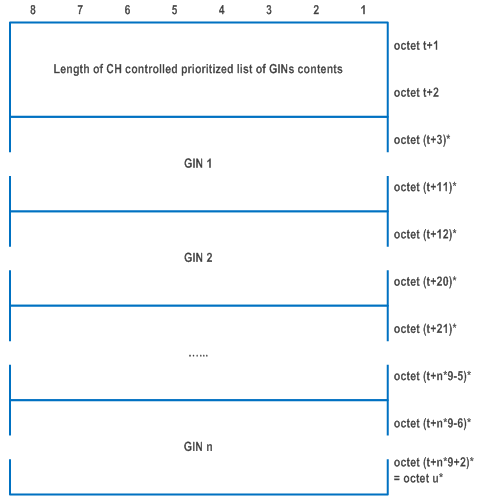
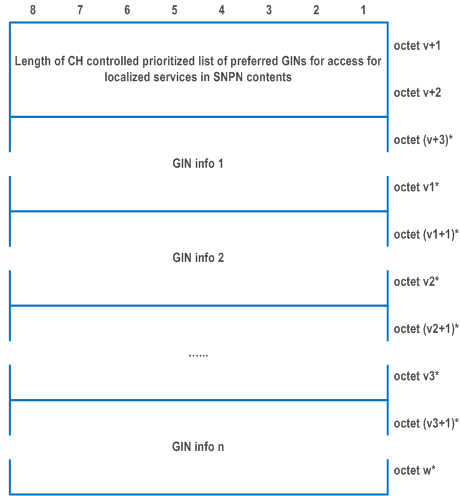
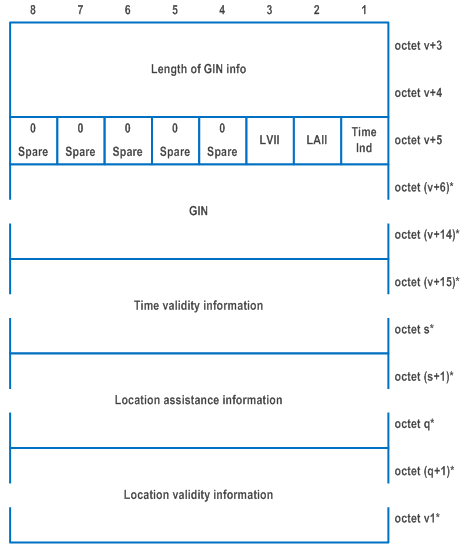
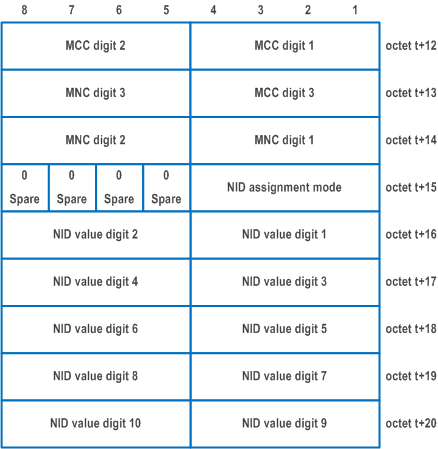
| Mobile country code (MCC): | |
| The MCC field is coded as in ITU-T Recommendation E.212 [42], Annex A. | |
| Mobile network code (MNC): | |
| The coding of MNC field is the responsibility of each administration but BCD coding shall be used. The MNC shall consist of 2 or 3 digits. If a network operator decides to use only two digits in the MNC, MNC digit 3 shall be coded as "1111". | |
| NID assignment mode (see NOTE) | |
| NID assignment mode is coded as specified in TS 23.003. | |
| NID value (see NOTE) | |
| NID value is coded as specified in TS 23.003. | |
| Time indication (bit 1 of octet v+5) | |
| 0 | Time validity information not included |
| 1 | Time validity information included |
| Location assistance information indicator (LAII) (bit 2 of octet v+5) | |
| 0 | Location assistance information not included |
| 1 | Location assistance information included |
| Location validity information indicator (LVII) (bit 3 of octet v+5) | |
| 0 | Location validity information not included |
| 1 | Location validity information included |
| Time period | |
| The time period field is coded as the route selection descriptor component value field for "time window type" specified in TS 24.526 Table 5.2.1. | |
| Location assistance information (oct(s+1)* to (q)*) | |
| The Location assistance information is coded according to Figure 9.11.3.51.11B and Table 9.11.3.51.5. | |
|
NOTE:
NID coding deviates from coding of value part of NID IE as specified in subclause 9.2.7 of TS 24.502, coding of the NID field of the SNPN list IE as specified in subclause 9.11.3.92, and coding of the NID field of the SNPN list with trusted 5G connectivity IE as specified in subclause H.2.4.7 of TS 24.302.
|
|